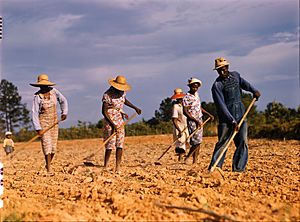Sharecropping facts for kids
Sharecropping is a way of farming where one person grows crops on land owned by someone else. Instead of paying rent with money, the farmer and the landowner share the crops that are grown. Sharecroppers were often very poor and usually owed money (were in debt) to the landowner or local stores.
This system was very common in the Southern United States after the Civil War ended and slavery was abolished. Many African-Americans who had been enslaved continued to farm the same land as sharecroppers. Sharecropping was part of a system called "Jim Crow", which made it hard for Black people to gain wealth and full rights.
Sharecropping became much more common in the Southern United States after slavery ended. However, it became rare there during the 20th century as new farming methods and economic changes took place.
Contents
Sharecropping is a type of farming where the landowner lets a farmer use their land. In return, the farmer gives a part of the harvest to the landowner. This is different from renting land with money. The landowner often provided the farmer with tools, seeds, and even a place to live.
After the Civil War, millions of enslaved people were freed. Most of them had no land, money, or tools. Landowners, on the other hand, had land but no longer had enslaved workers. Sharecropping seemed like a solution for both groups. It allowed freed people to continue farming and landowners to get their crops harvested.
Life for sharecroppers was very difficult. They often had to borrow money from the landowner or a local store (called a commissary) to buy food and supplies until the harvest. This created a cycle of debt. If the harvest was poor, they might not make enough money to pay back what they owed. This meant they started the next year already in debt, making it hard to ever get ahead.
The Debt Cycle
Imagine a sharecropper needing seeds and food. They would get these from the landowner's store. The cost would be written down. When the crops were sold, the landowner would take their share and also subtract the money owed for supplies. Often, there was little or no money left for the sharecropper. This made it very hard to escape poverty.
Sharecropping was closely tied to the "Jim Crow" system in the South. These laws and practices aimed to keep Black people separate from white people and limit their rights. Sharecropping helped keep many African Americans in a poor economic state. This made it harder for them to move away or get better jobs. It was a way to control their labor and lives even after slavery ended.
Impact on African Americans
For many African Americans, sharecropping was not much better than slavery. They worked hard but saw little reward. They often lived in small, simple cabins on the landowner's property. Their children often had to work in the fields instead of going to school. This system made it very difficult for families to improve their lives or gain true freedom.
Sharecropping began to decline in the 20th century. Several things led to its end:
- New Farming Methods: Machines like tractors made it possible to farm large areas with fewer workers.
- The Great Depression: This economic crisis in the 1930s made farming even harder.
- Migration: Many sharecroppers, both Black and white, moved to cities in the North and West looking for better jobs.
- Government Programs: Some government programs helped farmers, but they also sometimes pushed sharecroppers off the land.
By the middle of the 20th century, sharecropping was no longer a common way of farming in the United States.
Images for kids
See also
 In Spanish: Aparcería para niños
In Spanish: Aparcería para niños







